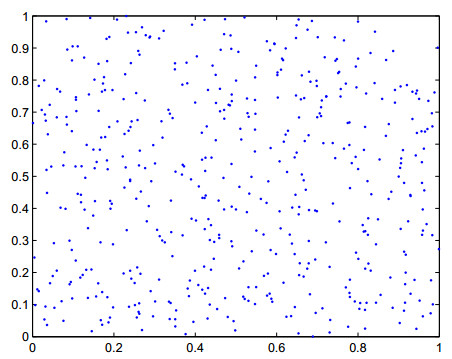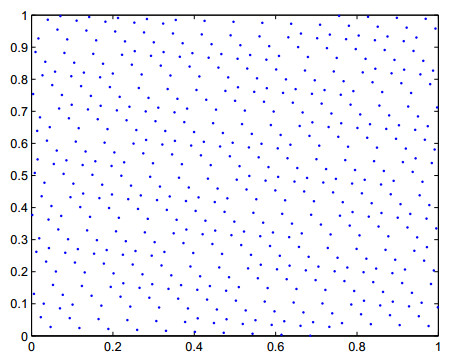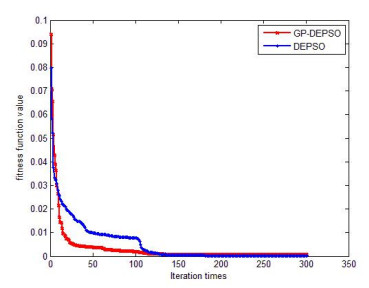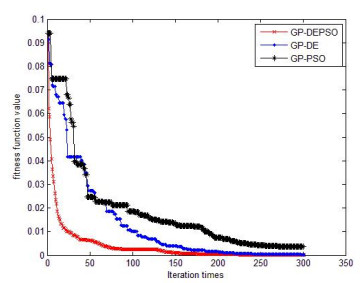In this paper, a hybrid differential evolution particle swarm optimization (PSO) method based on a good point set (GPDEPSO) is proposed to compute a finite noncooperative game among N people. Stochastic functional analysis is used to prove the convergence of this algorithm. First, an ergodic initial population is generated by using a good point set. Second, PSO is proposed and utilized as the variation operator to perform variation crossover selection with differential evolution (DE). Finally, the experimental results show that the proposed algorithm has a better convergence speed, accuracy, and global optimization ability than other existing algorithms in computing the Nash equilibrium of noncooperative games among N people. In particular, the efficiency of the algorithm is higher for determining the Nash equilibrium of a high-dimensional payoff matrix game.
1.
Introduction
The fundamental concept of fractional calculus involves replacing natural numbers with rational numbers in the order of differentiation operators. Although this concept may initially appear undeveloped and straightforward, it carries profound implications and yields significant results that effectively describe phenomena in various fields, including bioengineering, dynamics, modeling, control theory, and medicine. For more detailed information on this topic, we refer the reader to the following references [1,2,3,4]. Fractional differential equations (FDEs) play a critical role in modeling the growth of systems, particularly through nonlocal Cauchy-type problems that describe nonnegative quantities like species concentrations or temperature distributions. Before applying these models to real-world phenomena, it is crucial to establish the existence of solutions, which can be addressed using fixed point theory. Furthermore, it is essential to develop stable algorithms and reliable numerical procedures to obtain accurate results and ensure the practicality and validity of the models in real-life applications. The articles [5,6,7,8] and their references explore a wide range of interesting and innovative findings related to the existence and stability of coupled systems in various types of FDEs. These studies delve into different aspects of coupled systems and contribute to our understanding of their dynamics and properties. They provide valuable insights into the behavior and solutions of coupled FDEs, opening up avenues for further research and applications in this field. New strategies and methodologies have been developed to describe the dynamics of real problems. In particular, Caputo and Fabrizio [9] introduced a new class of fractional derivatives within the exponential kernel, which Losada and Nieto [10] explored further, uncovering intriguing characteristics. Atangana and Baleanu [11] investigated a novel type of fractional derivatives using Mittag-Leffler (ML) kernels. Abdeljawad [12] extended the ABC fractional derivative to higher arbitrary orders and included their associated integral operators. The reader may find theoretical works on the ABC fractional operator in references [13,14,15,16].
It is evident that the challenges posed by operators of variable order are more complex compared to operators of constant order. Recently, several authors have explored the applications of variable order derivatives in various scientific fields, including multi-fractional Gaussian noises, mechanical applications, and anomalous diffusion models. Among these, numerous studies have focused on developing numerical techniques for a specific class of variable-order FDEs, as exemplified by [17,18,19,20]. In this regard, Lorenzo et al. [21], utilizing fractional operators with variable order, addressed the problem of fractional diffusion. Subsequently, fractional variable order has found applications in various areas of science and engineering (see [22,23,24]). Sun et al. [25] conducted a comparative study between constant and variable order models to describe systems with memory. Various techniques are available for approximating solutions to fractional boundary value problems with variable orders. For instance, the authors in [26] developed a nonlinear model of alcoholism within the framework of FDEs with variable order and examined its solutions numerically and analytically. Recently, Li et al [27] investigated the following fractional problem using a novel numerical strategy
where, MLDω(ι)0+ is the Mittag-Leffler fractional derivative of order ω(ι). Kaabar et al. [28] examined the qualitative characteristics of the following implicit FDEs with variable order
where, CDω(ι)0+ is the Caputo fractional differential (FD) of variable order ω(ι). Jeelani et al. [29] employed generalized intervals, Krasnoselskii and Banach's fixed point theorems, and piecewise constant functions to conduct qualitative analyses on a nonlinear fractional integrodifferential equation.
Based on the provided justifications, we are motivated to evaluate and investigate the necessary conditions for a coupled system within the context of the ABC-fractional derivative with a variable order as the following
where
i)ABCDω(ι)0+ is the ABC-FD of variable order ω(ι)∈(1,2].
ii) τk,γk∈R, k=1,2,...,n, are prefixed points satisfying 0<κ1≤κ2≤...≤κn<b and 0<γ1≤γ2≤...≤γn<b.
iii) H1,H2:J×R2⟶R are continuous functions that comply with a few later-described presumptions.
To the best of our knowledge, no studies in the aforementioned body of research address an implicit coupled system of fractional variable order. The proposed implicit coupled system (1.3) is a more general form compared to the previous problems (1.1) and (1.2) in [26,28,29]. The proposed implicit coupled system (1.3) contains nonlocal conditions and variable order ω(ι)∈(1,2]. The complexity of calculations and partitioning the principal time interval has limited the number of studies specifically addressing the stability and existence of fractional integrodifferential boundary value problems with variable order. To bridge this gap, we conduct a comprehensive qualitative analysis of a new implicit coupled system (1.3) with a variable order within the framework of ABC fractional operators. By employing extended intervals and piecewise constant functions, we accurately transform the coupled system into an equivalent standard system with constant order in the context of the ABC-fractional derivative. The existence and uniqueness of solutions to the coupled system (1.3) are then demonstrated using fixed point techniques such as Krasnoselskii and Banach theorems. The Ulam-Hyers stability result of the suggested problem is also discussed. Additionally, we establish suitable conditions for the existence of effective solutions to the coupled system (1.3). The contributions of this work lie in providing a framework to address the challenges associated with variable-order FDEs involving the ABC fractional operator. The study offers transformation techniques, investigation of qualitative properties, existence and uniqueness analysis, stability analysis, and illustrative examples to support its findings. The results obtained in this study will contribute to understanding the stability properties of the considered implicit coupled system of fractional variable order. This knowledge is valuable for designing and controlling systems modeled using such equations, ensuring their robustness, and predicting their behavior accurately.
The paper's structure is as follows: Section 2 offers an overview of fractional calculus notations, definitions, and relevant lemmas, including a crucial lemma that converts the coupled system of ABC-fractional derivative into an equivalent integral equation. Section 3 focuses on establishing the existence and uniqueness of solutions for the coupled system, while Section 4 investigates the Ulam-Hyers stability of the system. To illustrate the obtained results, Section 5 presents numerical examples. Finally, the paper concludes with a summary of the findings, concluding remarks, and suggestions for potential future research directions.
2.
Preliminary results and essential concepts
Let C(J,R) be a Banach space consisting of all continuous functions y:J→R, where J:=(0,b] with the following supremum norm
Define the product space Υ=C(J,R)×C(J,R). Thus, Υ\ is Banach space with the following norm
for each (y1,y2)∈Υ.
Derivatives and integrals that have orders as functions of specific variables belong to the category of operators with variable order, which is a more complex classification. Variable order fractional integrals and derivatives can be defined in various ways.
Definition 2.1. [17] Let ω(ι)∈(n−1,n], y∈H1(J), then, the left ABC fractional derivative of order ω(ι) for function y(ι) with the lower limit zero are defined as
The normalization function Λ(ω(ι)) satisfies Λ(0)=Λ(1)=1, where Eω(ι) is the ML function defined by
The left Atangana-Baleanu (AB) fractional integral of order ω(ι) for function y(ι) are defined as
Lemma 2.2. [12] Let y(ι) be a function defined on the interval [0,b] and n<ω≤n+1, n∈N0. Then, we have
Theorem 2.3. [30] Let X be a Banach space and S⊂\ X be a nonempty, closed, convex and bounded subset. If there exist two operators Φ1,Φ2 satisfying the following conditions:
(1) Φ1u+Φ2v∈X, for all u,v∈X.
(2) Φ1 is completely continuous and Φ2 is a contraction mapping.
Then, there exists a function z∈S such that z=Φ1z+Φ2z.
Remark 2.4. Let u(ι),v(ι)∈C(J,R) be two continuous functions. Then, we have
Lemma 2.5. [12] Let ω∈(1,2] and ℏ∈C([a,b],R). Then, the following integral equation
is an equivalent to the following linear problem
where
2.1. Notations
For the sake of simplicity in our analysis, we will use the following notations:
and
2.2. Equivalent integral equations
In this part, we convert the coupled system (1.3) with variable-order ω(ι) into an equivalent integral equations. To begin, we transform the coupled system with variable order into a coupled system with constant order by using generalized intervals and piecewise constant functions. Let B be a partition of the interval J defined as
such that b0=0,bn=b and n∈N. Let ω(ι):J→(1,2] be a piecewise constant function concerning B. This means that the function ω(ι) takes values in the interval (1,2] and is constant over different intervals or "pieces" defined by the set B. In other words, for each interval in B, the function ω(ι) remains constant within that interval. The specific values of ω(ι) within each interval can vary, but they will always be within the range of (1,2]. The set B defines the partition or division of the domain J into different intervals, and within each interval, the function ω(ι) takes on a constant value. So, the function ω(ι) can be a representation as
where, ωi∈(1,2] are constants numbers, and Ui is the indicator of the interval Ji:=(bi−1,bi], i=1,2,...,n such that
Let C(Ji,R), i∈{1,2,...,n} be a Banach space of all continuous functions defined as yi:Ji→R with the following norm
By (2.1), the coupled system (1.3) can be expressed as
Then, for ι∈Ji,i=1,2,...,n the coupled system (2.4) on Ji can express as a sum of left ABC-coupled systems of constant-orders ω1,ω2,....ωn as follows
Let the function (y1,y2) be such that y1(ι)≡y2(ι)≡0 on ι∈[0,bi−1],i=1,2,....,n, and such that it solves the system (2.5). Hence, the coupled system (1.3) with variable-order ω(ι) is reduced to the following system
Now, to analyze the properties of solutions using fixed point theorems, we transform the coupled system (2.6) into an equivalent integral equation. For that, we present the following theorem.
Theorem 2.6. For i=1,2,...,n, let ωi∈(1,2], and H:Ji×R2→R be a continuous function and Θ1,Θ2≠0. If (y1,y2)∈Υ is a solution of coupled system (2.6), then, (y1,y2) satisfies the following fractional integral equations
and
where
Proof. We assume that (y1,y2)∈Υ is a solution of coupled system (2.6). Apply the operator ABIωib+i−1 to both sides of (2.6) and using Lemma 2.5, we get
and
By conditions y1(bi−1)=0 and y2(bi−1)=0, we get c1=c3=0. Hence. Eqs (2.9) and (2.10) become as
and
By second conditions y1(bi)=∑nk=1y1(τk) and y2(bi)=∑nk=1y2(γk), we get
and
Substitute the values of c1,c2,c3,c4 into (2.9) and (2.10), and we get (2.7) and (2.8). Conversely, assume that (y1,y2)∈Υ satisfies (2.7) and (2.8). Then, by applying ABCDωib+i−1 on both sides of (2.7) and (2.8), with using the fact ABCDωib+i−1(ι−bi−1)=0, we get (2.6). Next, take ι→τk in (2.7), and we get
In the same manner, we get y2(bi)=∑nk=1y2(γk). Thus, the nonlocal conditions are satisfied. □
For further analysis, we simplify the solutions (2.7) and (2.8) as
and
3.
Existence and uniqueness of solutions
In this part, we will examine the necessary conditions for the existence and uniqueness for the coupled system (2.6) by using some fixed point theorems.
Theorem 3.1. Suppose that
(H _{1} ) The functions \mathcal{H}_{1}, \mathcal{H}_{2}:\mathcal{J} _{i}\times \mathbb{R} ^{2}\rightarrow \mathbb{R} are continuous and there exist constant numbers \mathfrak{N}_{\mathcal{H} _{1}}, \mathfrak{N}_{\mathcal{H}_{2}} > 0 such that
for all x, y, \overline{x}, \overline{y}\in C\left(\mathcal{J}_{i}, \mathcal{ \mathbb{R} }\right). Then, the coupled system (2.6) has a unique solution provided that \max \left\{ \Omega _{1}, \Omega _{2}\right\} < 1 , where \Omega _{1} and \Omega _{2} are defined by (2.3).
Proof. On the light of Theorem 2.6, we define the operator \mathbf{ \Pi }:\Upsilon \rightarrow \Upsilon as
where
and
Let \beta _{\eta _{i}} be a closed ball defined as
with radius \eta _{i}\geq \frac{\left(\Phi _{1}+\Phi _{2}\right) }{1-\max \left\{ \Omega _{1}, \Omega _{2}\right\} }, and
where \mathcal{L}_{\mathcal{H}_{i}} = \max_{\iota \in \mathcal{J} _{i}}\left\vert \mathcal{H}_{_{i}}(\iota, 0, 0)\right\vert. Now, we show that \mathbf{\Pi }\beta _{\eta _{i}}\subset \beta _{\eta _{i}}. For the operator \mathbf{\Pi }_{1}, let \left(y_{1}, y_{1}\right) \in \beta _{\eta _{i}} and \iota \in \mathcal{J}_{i} . Then, we have
By \left(H_{1}\right) , we have
Hence
In the same manner, for the operator \mathbf{\Pi }_{2}, we get
Hence, by the fact \left\Vert \mathbf{\Pi }\left(y_{1}, y_{2}\right)
\right\Vert _{\Upsilon } = \left\Vert \mathbf{\Pi }_{1}\left(y_{1}, y_{2}\right) \right\Vert +\left\Vert \mathbf{\Pi }_{2}\left(y_{1}, y_{1}\right) \right\Vert, we get
Thus \mathbf{\Pi }\left(y_{1}, y_{2}\right) \in \beta _{\eta _{i}} . Now, we shall prove that \mathbf{\Pi }\left(y_{1}, y_{2}\right) is a contraction. Let \left(y_{1}, y_{2}\right), \left(\widehat{y}_{1}, \widehat{ y}_{2}\right) \in \beta _{\eta _{i}} and \iota \in \mathcal{J}_{i} . Then, for the operator \mathbf{\Pi }_{1}, we have
By (H _{1} ), we obtain
Hence
In the same manner, for the operator \mathbf{\Pi }_{1}, we get
Thus, we have
Due to \max \left\{ \Omega _{1}, \Omega _{2}\right\} < 1, we deduce that the operator \mathbf{\Pi } is a contraction mapping. Thus, \mathbf{\Pi } has a unique fixed point. By Banach contraction principle, we deduce that the coupled system (2.6) has a unique solution. □
Theorem 3.2. Under the hypothesis (H _{1} ) mentioned in Theorem 3.1. If Z_{\Pi }\max \left(\frac{\mathfrak{N}_{\mathcal{H}_{1}}}{1-\mathfrak{N}_{ \mathcal{H}_{1}}}, \frac{\mathfrak{N}_{\mathcal{H}_{2}}}{1-\mathfrak{N}_{ \mathcal{H}_{2}}}\right) < 1, then, the coupled system (2.6) has at least one solution
Proof. Define the operators \mathbf{F}_{1}, \mathbf{G}_{1}, \mathbf{F}_{2}, \mathbf{G} _{2}:\Upsilon \rightarrow \Upsilon as
From the above mentioned operators, we can write
and
Thus, the operator \mathbf{\Pi } can be expressed as
We split the proof into the following steps:
Step 1:In this step, we shall prove that \Pi is continuous. The continuity of \mathcal{H}_{y_{1}} and \mathcal{H}_{y_{2}} implies the continuity of \mathbf{F}_{1}, \mathbf{G}_{1}, \mathbf{F}_{2} and \mathbf{G}_{2} . Consequently, \mathbf{\Pi } is continuous.
Step 2: In this step, we shall prove that \mathbf{G}_{1} and \mathbf{G}_{2} are bounded. By (3.1), we have
In the same manner, we get
which implies
where
This proves \mathbf{G}_{1}, \mathbf{G}_{2} are uniformly bounded.
Step 3:In this step, we will prove that \mathbf{G}_{1} and \mathbf{G}_{2} are equicontinuous. For this purpose, let \left(y_{1}, y_{2}\right) \in \beta _{\eta _{l}} and \iota _{1}, \iota _{2}\in \mathcal{J} such that 0\leq \iota _{2} < \iota _{1}\leq b. Then, we have
Thus
In the same manner, we get
We conclude that the operator \mathbf{G}_{1} and \mathbf{G}_{2} are relatively compact. Based on the previous steps and using the Arzela-Ascoli theorem, we deduce that \mathbf{G} is completely continuous.
Step 4:In this step, we will prove that \mathbf{F}_{1} and \mathbf{F}_{2} are contractions. Let \left(y_{1}, y_{2}\right), \left(\widehat{y}_{1}, \widehat{y}_{2}\right) \in \beta _{\eta _{i}} and \iota \in \mathcal{J}_{i} . Then, for the operator \mathbf{F}_{1}, we have
Thus, we have
In the same manner, we get
Consequently,
Due to Z_{\Pi }\max \left(\frac{\mathfrak{N}_{\mathcal{H}_{1}}}{1-
\mathfrak{N}_{\mathcal{H}_{1}}}, \frac{\mathfrak{N}_{\mathcal{H}_{2}}}{1-
\mathfrak{N}_{\mathcal{H}_{2}}}\right) < 1, we deduce that the operator \mathbf{F} is contraction map. Hence, by Theorem 2.3, we see that \mathbf{\Pi } at least one fixed point, which is the corresponding solution \left(y_{1}, y_{2}\right) _{i} of the coupled system (2.6). For i\in \left\{ 1, 2, ..., n\right\} , we define the functions
As a result of this, it's well-known that, \left(y_{1}, y_{2}\right) _{i}\in C\left(\mathcal{J}_{i}, \mathcal{ \mathbb{R} }\right) \times C\left(\mathcal{J}_{i}, \mathcal{ \mathbb{R} }\right) given by (3.3) satisfies the following problem
and
where \left(y_{1}, y_{2}\right) _{i} is a solution to system (2.6) equipped with \left(y_{1}, y_{2}\right) _{i}(0)\equiv\left(y_{1}, y_{2}\right) _{i}(b_{i})\equiv\left(\widetilde{y}_{1}, \widetilde{y}_{2}\right) _{i}(b_{i})\equiv0. Then
is the solution for coupled system (2.6).
□
4.
Stability results of the coupled system (2.6)
In this section, we discuss Ulam-Hyers (UH) stability results for coupled system (2.6). For more information about the following definition see [31,32,33]. Let \varepsilon _{1}, \varepsilon _{2} > 0 , and y be a function such that y(\iota)\in C\left(\mathcal{J}_{i}, \mathcal{ \mathbb{R} }\right) satisfies the following inequalities:
Now, we defined the functions \left(y_{1}, y_{2}\right) _{i}(\iota), \left(\widehat{y}_{1}, \widehat{y}_{2}\right) _{i}(\iota) , \left(\Bbbk _{1}, \Bbbk _{2}\right) _{i}(\iota), \iota \in \mathcal{J}_{i} as
and
In the forthcoming analyses, we will use the above notations \left(y_{1}, y_{2}\right) (\iota), \left(\widehat{y}_{1}, \widehat{y}_{2}\right) (\iota)\ and \left(\Bbbk _{1}, \Bbbk _{2}\right) (\iota).
Definition 4.1. The coupled system (2.6) is UH stable if there is a real number C_{\mathcal{H}} = \max \left\{ C_{\mathcal{H}_{1}}, C_{\mathcal{H} _{2}}\right\} > 0 such that for each \varepsilon = \max \{\varepsilon _{1}, \varepsilon _{2}\} > 0, and each solution \left(\widehat{y}_{1}, \widehat{y}_{2}\right) \in \Upsilon of coupled system (2.6) satisfying the inequalities (4.1), there exists a solution \left(y_{1}, y_{2}\right) \in \Upsilon of coupled system (2.6) such that
where \left(y_{1}, y_{2}\right) and \left(\widehat{y}_{1}, \widehat{y} _{2}\right) defined in (4.2) and (4.3), respectively.
Remark 4.2. Let \left(\widehat{y}_{1}, \widehat{y}_{2}\right) \in \Upsilon be solutions of the inequalities (4.1) if and only if there is a function \left(\Bbbk _{1}, \Bbbk _{2}\right) (\iota)\in \Upsilon (which depends on \left(y_{1}, y_{2}\right)) \ satisfying the following conditions,
i) \left\{ \begin{array}{c} \left\vert \Bbbk _{1}(\iota)\right\vert \leq \varepsilon _{1}{ \ }for { \ }all{ \ }\iota \in \mathcal{J}, \\ \left\vert \Bbbk _{2}(\iota)\right\vert \leq \varepsilon _{2}{ \ }for { \ }all{ \ }\iota \in \mathcal{J}, \end{array} \right.
ii) \left\{ \begin{array}{c} {^{ABC}}\mathbf{D}_{b_{i-1}^{+}}^{\omega _{i}}\widehat{y}_{1}(\iota) = \mathcal{H}_{\widehat{y}_{1}}(\iota)+\Bbbk _{1}(\iota), \iota \in \mathcal{J }, \\ {^{ABC}}\mathbf{D}_{b_{i-1}^{+}}^{\omega _{i}}\widehat{y}_{2}(\iota) = \mathcal{H}_{\widehat{y}_{2}}(\iota)+\Bbbk _{2}(\iota), \iota \in \mathcal{J }. \end{array} \right.
Lemma 4.3. Let \left(\widehat{y}_{1}, \widehat{y}_{2}\right) \in \Upsilon be satisfying (4.1), then \left(\widehat{y}_{1}, \widehat{y} _{2}\right) satisfy the following inequalities
where
and
Proof. By Remark 4.2, we have
Then, by Theorem 2.6, the solutions of the system (4.4) are given as
and
By some calculations, we get
□
Theorem 4.4. Suppose that \left(H_{1}\right) holds. If
then the coupled system (2.6) is UH stable.
Proof. Let \varepsilon = \max \{\varepsilon _{1}, \varepsilon _{2}\} > 0 and \left(\widehat{y}_{1}, \widehat{y}_{2}\right) \in \Upsilon be a solution of coupled system (2.6) satisfying (4.1), and let \left(y_{1}, y_{2}\right) \in \Upsilon be the unique solution of the coupled system (2.6). Then, by Theorem 2.6, the solution of coupled system (2.6) is given by
Hence by Lemma 4.3 and \left(H_{1}\right), we have
Thus
where
In the same manner, we have
where
Thus, we have
Hence, coupled system (2.6) is UH stability. Now, by choosing C_{\mathcal{H }}(\varepsilon) = C_{\mathcal{H}}\varepsilon such that C_{\mathcal{H} }(0) = 0 , we conclude that coupled system (2.6) has Generalized UH stability. □
5.
Examples
To illustrate our key results, this section presents numerical examples addressing the coupled system (2.6) in the context of ABC-fractional derivative with variable order \omega (\iota) . These specific examples have been chosen based on the conditions outlined in the theorems used, the specific conditions mentioned in our proposed conclusions, and the values of parameters and fractional-order derivatives. These examples serve as an illustration of the various dynamic applications that can be created by combining the ABC-fractional derivative with variable order \omega (\iota) .
Example 5.1. Let us consider the following coupled system of ABC fractional problem with variable order \omega (\iota)
Here, a = 0, b = 2 , and
Let \iota \in \left[0, 1\right], y_{1}, \overline{y}_{1}\in C\left(\mathcal{ J}_{i}, \mathcal{ \mathbb{R} }\right). Then
and
Therefore, hypothesis (H _{1} ) holds with \mathfrak{N}_{\mathcal{H}_{1}} = \frac{1}{5} and \mathfrak{N}_{\mathcal{H}_{2}} = \frac{1}{2}. Let
Then, for i = 1, by some calculation, we get \Omega _{1} = 0.65 and \Omega _{2} = 0.52 and hence \Omega = \max \left\{ \Omega _{1}, \Omega _{2}\right\} = 0.65 < 1. Thus, by Theorem 3.1, the coupled system of ABC (2.6) has a unique solution. For every \varepsilon = \max \{\varepsilon _{1}, \varepsilon _{2}\} > 0 and each \left(\widehat{y}_{1}, \widehat{y} _{2}\right) \in \Upsilon satisfying
there exists a solution \left(y_{1}, y_{2}\right) \in \Upsilon of the coupled system of ABC (2.6) with
where
and
Thus,
Therefore, by Theorem 4.4, the coupled system (2.6) is UH stable. Now, let C_{\mathcal{H}}(\varepsilon) = C_{\mathcal{H}}\varepsilon such that C_{\mathcal{H}}(0) = 0 , then the coupled system of ABC-fractional derivative (2.6) is GUH stability.
For i = 2, with some calculation, we have \Omega _{1} = 0.55 and \Omega _{2} = 0.43 , and hence, \Omega = \max \left\{ \Omega _{1}, \Omega _{2}\right\} = 0.55 < 1. Then, by Theorem 3.1, the coupled system (2.6) has a unique solution. For every \varepsilon = \max \{\varepsilon _{1}, \varepsilon _{2}\} > 0 and each \left(\widehat{y}_{1}, \widehat{y}_{2}\right) \in \Upsilon satisfying
there exists a solution \left(y_{1}, y_{2}\right) \in \Upsilon of the coupled system of ABC-fractional derivative (2.6) with
where C_{\mathcal{H}} = \max \left\{ C_{\mathcal{H}_{1}}, C_{\mathcal{H} _{2}}\right\} > 0 . Therefore, by Theorem 4.4, the coupled system (2.6) is UH stable. Now, by choosing C_{ \mathcal{H}}(\varepsilon) = C_{\mathcal{H}}\varepsilon such that C_{ \mathcal{H}}(0) = 0 , the coupled system (2.6) is a Generalized UH stability.
6.
Conclusions
Recent research has emphasized the Atangana-Baleanu fractional derivative, leading to the study and development of various qualitative features of solutions to FDEs incorporating these operators. This research paper presents a novel investigation into an implicit coupled system of fractional variable order, filling a gap in the existing literature. In this context, we have established and examined the necessary conditions for the existence and uniqueness of solutions to the coupled system of the ABC fractional problem with variable order, without relying on the semigroup property. We utilized extended intervals, piecewise constant functions, and fixed point theorems of the Banach-type and Krasnoselskii-type to reduce the proposed ABC system into a fractional integral equation. Furthermore, we employed mathematical analysis tools to investigate the stability results in the UH sense. An illustrative example in two cases was provided to support the findings of the study. By extending the existing conclusions examined for the ABC operator, this research contributes to advancing the understanding of variable-order FDEs. The paper provides a solid theoretical foundation that can be further explored through analysis, numerical simulations, and practical applications. The transformation techniques, qualitative analysis, and illustrative examples presented in this work highlight its unique contributions and potential to serve as a foundation for future research in the field. Overall, this research paper expands the knowledge and understanding of variable-order FDEs, offering valuable insights and paving the way for further advancements in the field. We believe that the results obtained in this study will be significant for future research in the field of fractional calculus theory, given the recent extensive explorations and applications of the Mittag-Leffler power law.
Use of AI tools declaration
The authors declare they have not used Artificial Intelligence (AI) tools in the creation of this article.
Conflict of interest
It is noted that the authors declare no conflicts of interest in the research study.
Funding
This research was funded by the Zhejiang Normal University Research Fund under Grant YS304223919.

















 DownLoad:
DownLoad: